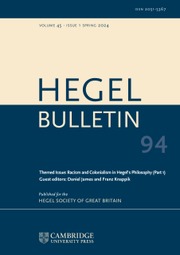No CrossRef data available.
Article contents
Jon Stewart, Hegel’s Century: Alienation and Recognition in the Age of Revolution. Cambridge: Cambridge University Press, 2021. ISBN: 978-1-316-51998-1 (hbk). Pp. 344. £29.99.
Review products
Jon Stewart, Hegel’s Century: Alienation and Recognition in the Age of Revolution. Cambridge: Cambridge University Press, 2021. ISBN: 978-1-316-51998-1 (hbk). Pp. 344. £29.99.
Published online by Cambridge University Press: 02 December 2024
Abstract
An abstract is not available for this content so a preview has been provided. Please use the Get access link above for information on how to access this content.
- Type
- Book Review
- Information
- Copyright
- © The Author(s), 2024. Published by Cambridge University Press on behalf of The Hegel Society of Great Britain.



